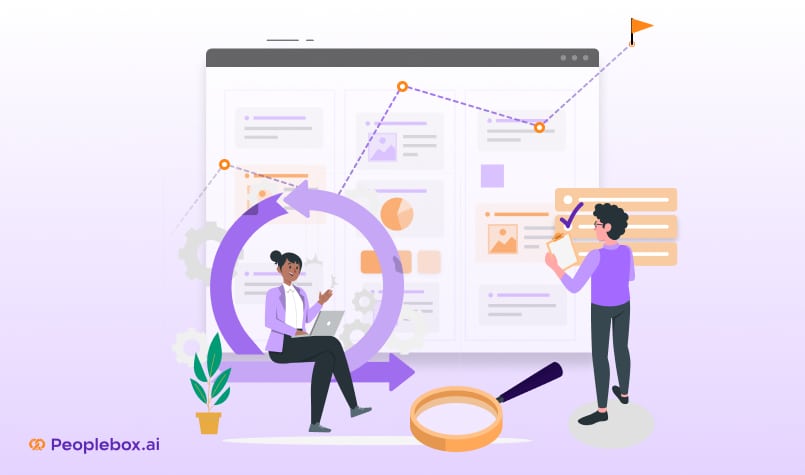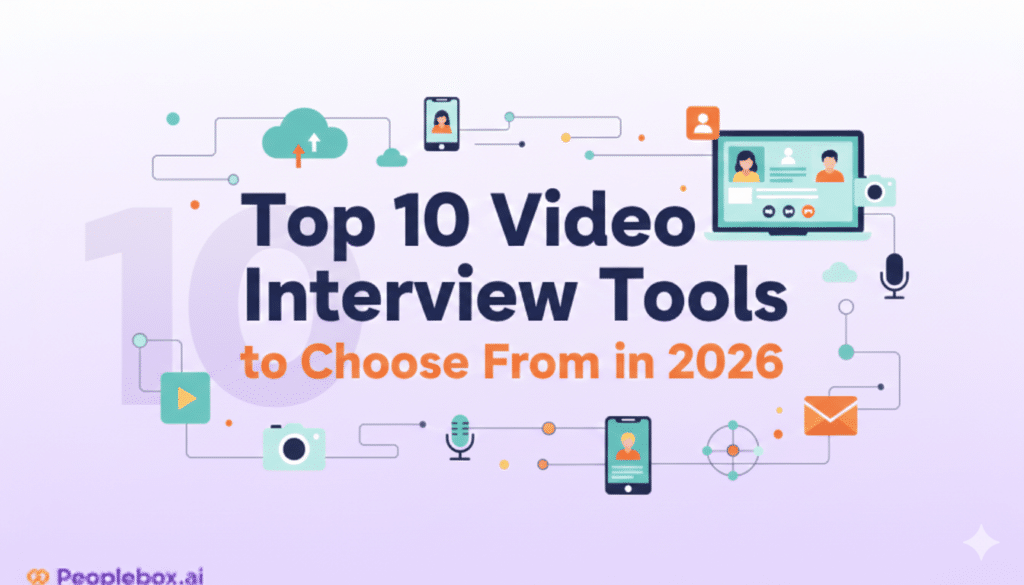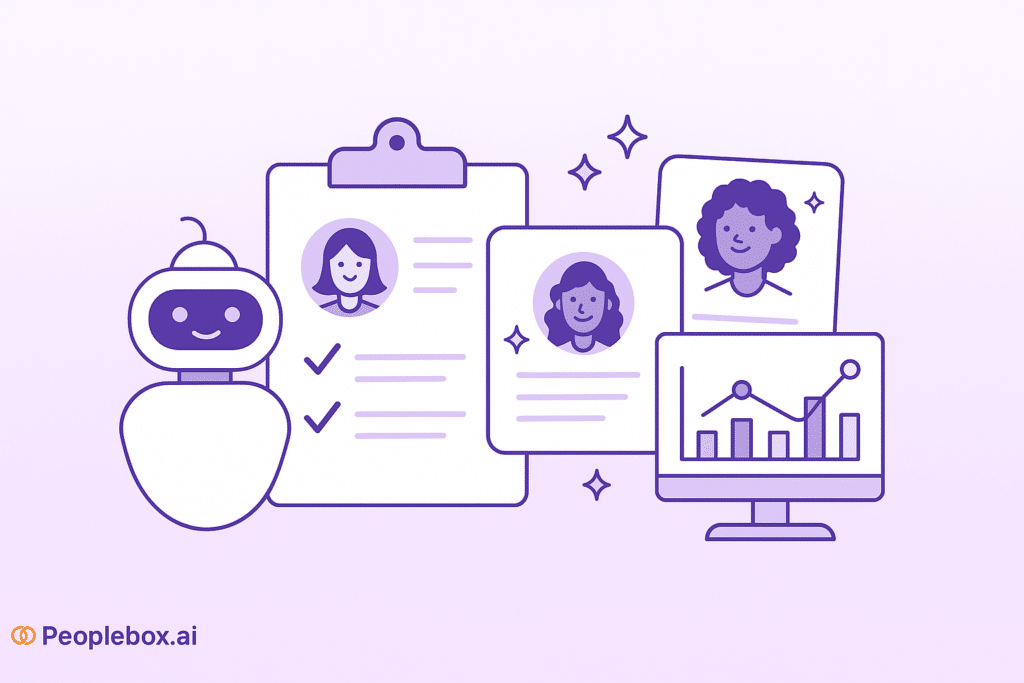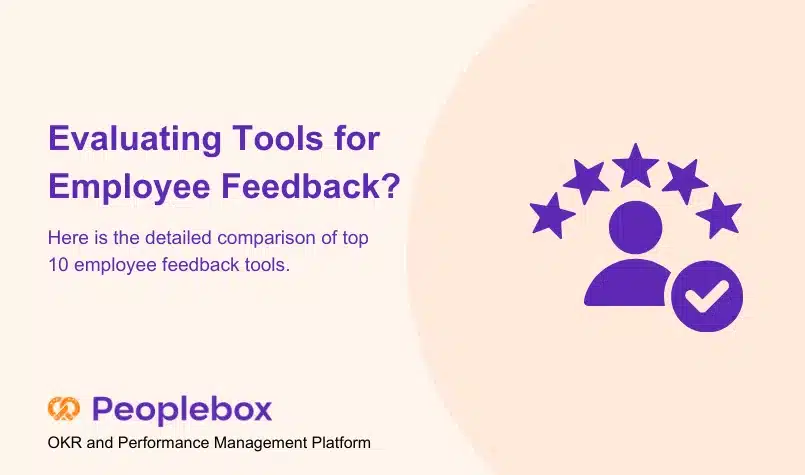TL;DR
Too many tools = fragmented data, delayed insights, and missed signals. This checklist helps you evaluate platforms that actually drive business impact.
✅ Talent Lifecycle Coverage
✅ Real-Time Visibility for Managers
✅ Predictive Analytics
✅ Ease of Adoption
✅ Integration Flexibility
✅ Scalability and Customization
✅ Security and Compliance
Scroll down for practical questions under each pillar so you don’t just buy software, you invest in outcomes.
What if your top performers are slipping and you can’t see it until they leave?
In 2025, HR leaders aren’t short on tools they’re drowning in them. Performance reviews happen in one app, engagement surveys in another, and OKRs are scattered across spreadsheets. The result? Blind spots. Missed signals. And talent walking out the door before anyone even notices.
The real problem isn’t the tools, it’s the fragmentation.
Without a unified view, managers can’t coach, HR lacks timely insights, and employees lose direction. What should be a strategic advantage becomes an operational burden.
This checklist isn’t just a feature comparison, it’s a way to audit whether your Talent Management Platform actually helps you retain top talent, drive performance, and scale culture with clarity.
1. Does the platform support key stages of the employee lifecycle?
Ensure your platform supports every stage of the employee journey from onboarding to leadership development.
A unified view across the entire lifecycle improves decision-making, reduces tool sprawl, and empowers managers with context.
- Goal setting & OKRs
Can managers and employees align on quarterly goals? Does the platform support cascading OKRs and show how individual goals contribute to company priorities? - Continuous performance reviews
Does it support frequent, lightweight check-ins not just annual reviews so feedback becomes a habit, not a formality? - 1:1s and feedback cycles
Are conversations structured and trackable? Can managers capture ongoing feedback and use prompts to guide meaningful check-ins? - Engagement & pulse surveys
Are surveys customizable, frequent, and linked to performance data? Can insights be used to improve team morale and reduce attrition? - Learning and development plans
Can development goals be tracked? Are upskilling paths personalized and tied to performance outcomes? - Succession & career planning
Does the platform help identify high-potential talent? Can you map career paths and track readiness for future roles?
Why it matters: Consolidating these functions reduces tool fatigue and improves data flow between touchpoints.
2. Can managers act quickly with a clear view of their team?
- Unified dashboards across performance, goals, and engagement
Does the dashboard give a real-time, all-in-one view of each employee’s goals, performance, and engagement trends? - Manager-specific insights and alerts
Are alerts tailored to flag what matters like low engagement or overdue goals and delivered where managers already work? - Built-in coaching recommendations
Does the platform suggest next steps like whom to recognize or support, and offer prompts or templates for effective 1:1s?
Why it matters: Managers can’t act on what they can’t see. Real-time, contextual insights lead to faster, smarter decisions.
3. Does the platform help move from reactive firefighting to proactive decision-making?

- Early alerts on flight risks and performance dips
Can the system flag disengagement, burnout signals, or slipping performance before it’s too late? - Talent heatmaps and growth trajectory insights
Does it help visualize high-potential talent, succession gaps, and readiness for new roles at a glance? - Performance + engagement data in one view
Are trends analyzed together to uncover root causes and prioritize interventions?
Why it matters: Predictive platforms don’t just report the past they guide next steps. Spot risks early, support growth proactively, and reduce preventable attrition.
4. Will the platform be embraced by your team without friction?
- Intuitive experience for managers and employees
Is the UI clean, familiar, and easy to use across all levels without needing a manual? - Quick setup with low IT effort
Can the platform be implemented in weeks, not months, with minimal reliance on internal tech teams? - Reliable support and learning resources
Does it come with guided onboarding, in-app assistance, and a responsive customer success team? - Built-in best practices
Are templates and workflows pre-configured to match how modern teams work?
Why it matters: Even the best platform fails without adoption. A frictionless experience encourages daily use, drives faster ROI, and keeps everyone aligned.
5. Can the platform work seamlessly with your existing HR tech stack without creating more silos?
- Pre-built connectors for HRIS, payroll, and communication tools
Does it integrate out-of-the-box with tools like Workday, SAP, Slack, or MS Teams? - Bi-directional sync with OKRs, ATS, and learning systems
Can it push and pull real-time data from systems already in use, avoiding manual updates? - Open APIs and webhooks for custom workflows
Is there flexibility to build your own automations or connect niche tools when needed?
Why it matters: The right platform should fit into your ecosystem, not replace it. Seamless integration ensures data stays consistent, usable, and actionable across systems.
6. Can the platform adapt as your organization evolves without creating friction?
- Role-based access and multi-team setup
Can different teams, departments, or business units operate independently while following shared standards? - Custom workflows for reviews, surveys, and feedback loops
Can you tailor processes to match how your organization actually works without depending on vendor support? - Configurable fields, forms, and dashboards
Can admins easily adjust templates, rating scales, or reporting views as business needs change?
Why it matters: As org complexity increases, rigid tools break down. The right platform scales without slowing you down supporting both structure and flexibility.
7. Does the platform meet the highest standards for protecting employee data and ensuring legal compliance?
- SOC 2 / ISO 27001 compliance
Is the platform audited for industry-recognized security frameworks to ensure enterprise-grade protection? - Granular role-based access control
Can you define who can view, edit, or manage specific data across different teams, levels, or geographies? - GDPR-ready and global compliance
Does the system support data privacy laws like GDPR, with options for consent management, data residency, and audit trails?
Why it matters: Talent data is sensitive. A secure platform not only protects your people, it also protects your brand, operations, and compliance posture.
Platform Comparison: Choosing the Right Talent Management Solution
Use this quick comparison to evaluate how Peoplebox.ai, Lattice, and 15Five stack up on critical features like unified workflows, predictive analytics, integrations, and setup time so you don’t just choose a tool, you choose outcomes.
| Peoplebox.ai | Lattice | 15Five |
| Unified OKRs, Reviews & Engagement | ||
| All-in-one platform integrating OKRs, reviews, feedback and engagement seamlessly | Requires multiple products; not fully integrated in a single experience | OKRs via paid add-on; separate from review cycle |
| Real-Time Manager Insights | ||
| Dashboards surface engagement trends, flight risk and team health in real time | Offers dashboards but limited context and alerts | Basic insights; advanced features require additional modules |
| Predictive Analytics | ||
| Built-in predictive models for attrition and high-talent spotting | No predictive analytics features noted | No predictive analytics |
| Native 1:1 & Feedback Workflows | ||
| Structured 1:1s, continuous feedback, agenda and notes built-in | Strong performance feedback and review tools | 1:1s and weekly check‑ins are core to the product |
| Deep Slack/MS Teams Integration | ||
| Direct workflows, nudges, surveys, and data syncing with Slack/Teams | Basic Slack integration; limited Microsoft Teams support | Limited integration depth; workflows often manual |
| Setup Time | ||
| Typically deploys within 2 weeks for end-to-end setup | Deployment can take 4–6 weeks depending on configuration | Rollout period ranges from 3–5 weeks |
| Pricing Transparency | ||
| Clear pricing tiers; upfront and user-based | Custom quoting required; pricing not public | Custom quote model; no public pricing |
| SOC 2 / ISO 27001 Compliance | ||
| Enterprise-grade certifications and compliance standards | Offers enterprise security features; widely used in mid-large orgs | Trusted by enterprises; complies with standard security frameworks |
It’s not just about checking boxes, it’s about how well each feature works together to improve manager effectiveness, employee growth, and organizational clarity.
The comparison above breaks down core capabilities, but just as important is how you use these insights.
| Turn Your Self-Evaluation Into Action Don’t let blind spots cost you talent. Your platform should drive alignment, retention, and performance not hold you back. Download the PDF template now. |
Make Talent Outcomes Your Competitive Advantage
A modern Talent Management Lifecycle Platform should do more than list features; it should deliver business results. As you evaluate options, consider how Peoplebox.ai stands out:
✅ Unified Talent Stack
Combines OKRs, performance reviews, engagement surveys, 1:1s, and feedback no more switching between tools.
✅ Real-Time Insights
Surfaces flight risks, low engagement, and performance drops before they become issues.
✅ Built for Managers
Empowers managers with coaching nudges, goal visibility, and team health dashboards.
✅ Deep Integrations
Seamlessly connects with your HRIS, Slack, Teams, and more zero disruption to workflows.
✅ Fast Adoption, Zero Clutter
Intuitive UX ensures your teams actually use it, without long training cycles or change fatigue.
✅ Scales as You Grow
Customizable workflows and reporting adapt to your org’s structure and evolving needs.
If your current tools aren’t helping you turn talent data into a strategic advantage, it’s time to switch.
Peoplebox.ai helps HR and business leaders drive alignment, retention, and performance at scale.
Frequently Asked Questions(FAQs)
What is a Talent Management Lifecycle Platform?
A Talent Management Lifecycle Platform is an HR tool that unifies performance reviews, goal setting (OKRs), engagement surveys, feedback, and succession planning supporting every stage of the employee journey.
Why do HR leaders need an all-in-one talent platform in 2025?
In 2025, HRs are overloaded with fragmented tools. A unified platform reduces blind spots, enables real-time insights, and helps retain top talent proactively.
What should I look for in a talent management platform?
Key features include:
- End-to-end talent lifecycle coverage
- Real-time dashboards for managers
- Predictive analytics for attrition and growth
- Seamless integrations (HRIS, Slack, ATS)
- Ease of adoption and fast setup
- Compliance with SOC 2 / ISO 27001 / GDPR
What’s the difference between Peoplebox.ai, Lattice, and 15Five?
Peoplebox.ai offers an all-in-one unified platform with built-in predictive analytics and deep Slack/MS Teams integration. Lattice and 15Five require multiple modules or add-ons for similar functionality.
How can I evaluate if my HR tools are still effective?
Use a strategic checklist to audit capabilities like OKRs, performance reviews, real-time visibility, and predictive insights. If your current stack lacks integration or real-time support, it may be time to upgrade.






